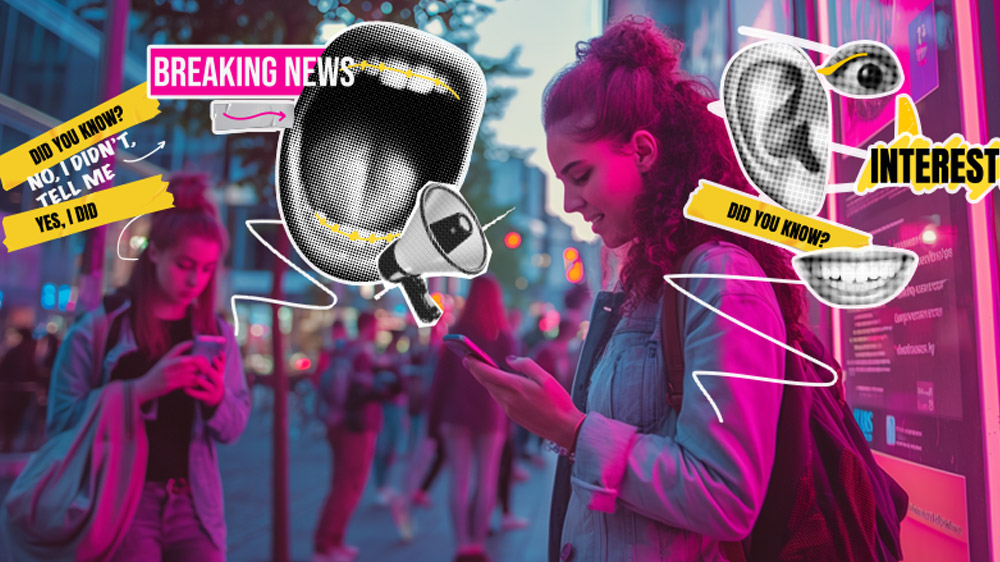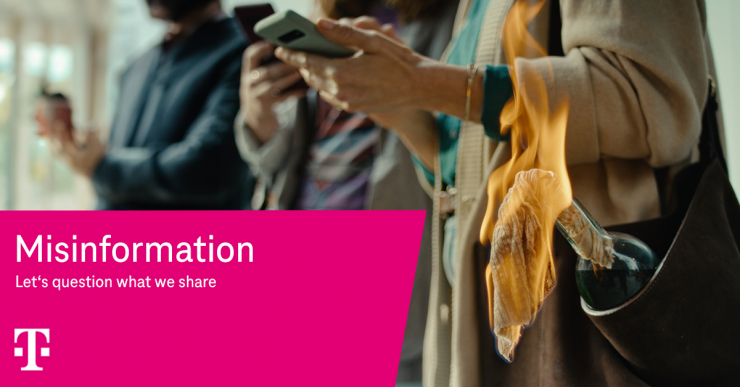The year 2024 will be marked by major elections around the world, from the USA to Europe and India. But as the democratic process continues, a worrying development is spreading: the distribution of disinformation via various digital channels. A striking number of populist movements rely on fake news and manipulation using artificial intelligence (AI) to influence public opinion. In the midst of these challenges, it is crucial to strengthen media literacy. For in a digital era in which fake news and deepfakes are circulating, the ability to evaluate and critically differentiate information is of the utmost importance.
In addition, mistrust in media, especially digital media, is increasing. The World Economic Forum classifies the spread of misinformation through artificial intelligence as the greatest risk of a global crisis in the next two years. According to the Bertelsmann study “Insecure public”, half of all participants say that they do not feel able to reliably assess information on the internet.

In addition, mistrust in media, especially digital media, is increasing. The World Economic Forum (Source: Global Risks Report 2024) classifies the spread of misinformation through artificial intelligence as the greatest risk of a global crisis in the next two years. According to the Bertelsmann study “Insecure public”, half of all participants say that they do not feel able to reliably assess information on the internet.
Regardless of which digital channels you use to obtain information, such as search engines, social media or messaging services, you will more or less come into contact with deliberately created disinformation. Once uncovered, however, reporting also leads to increased skepticism towards trusted sources of information. A dilemma that can ultimately only be resolved through constant awareness-raising and educational formats tailored to the target group.
What is disinformation?
Disinformation is deliberately spread false or misleading information with the aim of causing damage and spreading uncertainty. The terms misinformation and fake news are often used synonymously with disinformation, although misinformation is “accidentally” false information. This also includes the classic canard, clickbaiting, satire or parodies.Disinformation is spread through a variety of media, from traditional methods to newer digital methods. Modern phenomena include deepfakes, social bots and framing, which are becoming increasingly important. Traditional techniques, on the other hand, include fake photos, imitation websites, misleading or abbreviated quotes taken out of context, inaccurate statistics and fictitious claims.
What is the role of artificial intelligence?
Artificial intelligence (AI) is playing an increasingly important role in the creation and distribution of disinformation, as it has never been so easy to create false information of such perfect quality and in such large quantities. Texts, images, audio and even videos can be produced in just a few simple steps and disinformation or deepfakes can be created almost at will and even distributed automatically.While the progressive development of AI offers the transformative power to help solve the major problems of our society, such as climate change, participation, education and healthcare, it also creates the opportunity to use the technology for disinformation. At the same time, AI can promote the spread of disinformation, weakening diversity of opinion and reinforcing existing inequalities through systemic BIAS.
Deep fakes are media content such as photos, audio files or videos that have been edited using AI technologies to make them appear extremely realistic. This technique makes it possible to imitate or replace faces and voices, allowing people in videos to say or do things that never happened. Deepfakes can be used to manipulate or fake events and pose a threat because they can undermine the credibility of established news media by producing content that looks like it comes from trusted sources.
Social bots are automated programs that mimic human activity on social networks. They can independently post, share or respond to comments and are often used for automated customer service to answer questions and solve simple problems around the clock. The problematic use of social bots arises when they are used to artificially amplify political opinions or issues, which can give the impression of broader support or opposition than actually exists.
By using AI, these bots can quickly spread biased views and influence public opinion by “authentically” reflecting opinions that do not necessarily correspond to the majority opinion. Their algorithmic amplification gives them disproportionate influence, which can lead to a distorted perception of public opinion and impair the quality of democratic discourse.
By using AI, these bots can quickly spread biased views and influence public opinion by “authentically” reflecting opinions that do not necessarily correspond to the majority opinion. Their algorithmic amplification gives them disproportionate influence, which can lead to a distorted perception of public opinion and impair the quality of democratic discourse.
Framing describes how information is presented in order to promote specific perspectives or reactions. It is the shaping of content through language, images or design to influence specific associations or opinions.
Frames do not have to be misleading or manipulative; they are a fundamental part of communication. Nevertheless, frames can be used strategically to shape opinions by supporting certain interpretations and minimizing or excluding other points of view.
Frames do not have to be misleading or manipulative; they are a fundamental part of communication. Nevertheless, frames can be used strategically to shape opinions by supporting certain interpretations and minimizing or excluding other points of view.
Summary
Disinformation poses a major challenge, not least due to the capabilities of AI. Content is distributed, shared, commented on and liked extremely quickly and broadly on the internet, especially on social media and messaging services. The information is not verified for accuracy by the platform operators. In addition, the limited scope of such messages (character limit on Twitter, short descriptions for posts on Instagram & Co., no text level for voice messages, stories and reels, etc.) often leaves no room for sources or references. If you also take into account the deliberately entertaining consumption on platforms such as Instagram and TikTok, which is controlled by the platform operators, this quickly leads to overwhelming situations and reduces both our ability and our “desire” to assess trustworthiness. This can have a significant impact on social cohesion and, particularly with regard to adolescents, we all have a duty to consider and pass on the following points:
Question critically instead of forwarding directly
Use fact checks
Check the originator of the message
Compare sources
Check images/videos
Do not create disinformation even when using AI
Inform others about your findings
Report disinformation within the platform
Only share content that you are sure about
In our themed dossier “Disinformation in times of artificial intelligence ”, we address many aspects of disinformation with interactive formats, background texts and very specific recommendations for action and would like to support adult mentors in providing young people with competent guidance.
Technical terms
Canard
A canard is a false or invented news item published in the media. It is often the result of errors in research or is sometimes deliberately spread as a joke.
A canard is a false or invented news item published in the media. It is often the result of errors in research or is sometimes deliberately spread as a joke.
Click baiting
Click baiting is a technique that uses particularly sensational or misleading headlines to encourage users to click on a link. The aim is to increase the number of clicks, which often leads to disappointment among readers as the content does not fulfill the promises of the headline.
Click baiting is a technique that uses particularly sensational or misleading headlines to encourage users to click on a link. The aim is to increase the number of clicks, which often leads to disappointment among readers as the content does not fulfill the promises of the headline.
Parody
A parody is a humorous or mocking imitation of a work, style or author that emphasizes characteristic elements through exaggeration or distortion. It aims to criticize or mock the original by comically exaggerating its peculiarities.
A parody is a humorous or mocking imitation of a work, style or author that emphasizes characteristic elements through exaggeration or distortion. It aims to criticize or mock the original by comically exaggerating its peculiarities.
Satire
Satire is an art form that criticizes and exposes human faults or vices through mockery, irony or other humorous means. It strives to bring about social or individual change through its critical portrayal.
Satire is an art form that criticizes and exposes human faults or vices through mockery, irony or other humorous means. It strives to bring about social or individual change through its critical portrayal.
Bias
In artificial intelligence (AI) applications, “bias” refers to a systematic distortion in the data or algorithms that can cause the results of the AI to be slanted or biased in a certain way. Such biases are often caused by unbalanced training data or biases in the development of algorithms. A bias can lead to unfair or discriminatory results, for example when certain groups of people are systematically disadvantaged.
In artificial intelligence (AI) applications, “bias” refers to a systematic distortion in the data or algorithms that can cause the results of the AI to be slanted or biased in a certain way. Such biases are often caused by unbalanced training data or biases in the development of algorithms. A bias can lead to unfair or discriminatory results, for example when certain groups of people are systematically disadvantaged.
Did you like this article?
Read more in "Desinformation"
 Deutsche Telekom impressively demonstrates the destructive power of disinformation and calls on us to double check the content we share. At a time when misinformation is spreading faster than ever before, Deutsche Telekom is joining forces with its partner organizations to raise awareness of this pressing social issue.
No Hate Speech - No Chance for Misinformation
Deutsche Telekom impressively demonstrates the destructive power of disinformation and calls on us to double check the content we share. At a time when misinformation is spreading faster than ever before, Deutsche Telekom is joining forces with its partner organizations to raise awareness of this pressing social issue.
No Hate Speech - No Chance for Misinformation
 Disinformation, reinforced by artificial intelligence, is difficult to recognize and spreads rapidly via social media and messenger services. For better orientation and to be able to support young people effectively, you can find out more about the strategies here.
Fake News – Strategies of Disinformation
Disinformation, reinforced by artificial intelligence, is difficult to recognize and spreads rapidly via social media and messenger services. For better orientation and to be able to support young people effectively, you can find out more about the strategies here.
Fake News – Strategies of Disinformation
Interactive learning module: Disinformation
Infographic: Mechanisms of disinformation
Share this article!
Post the article with one click!
Share
